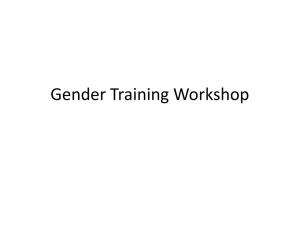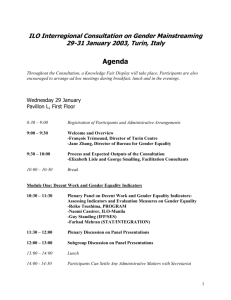Glossary of Gender-related Terms and Concepts
advertisement
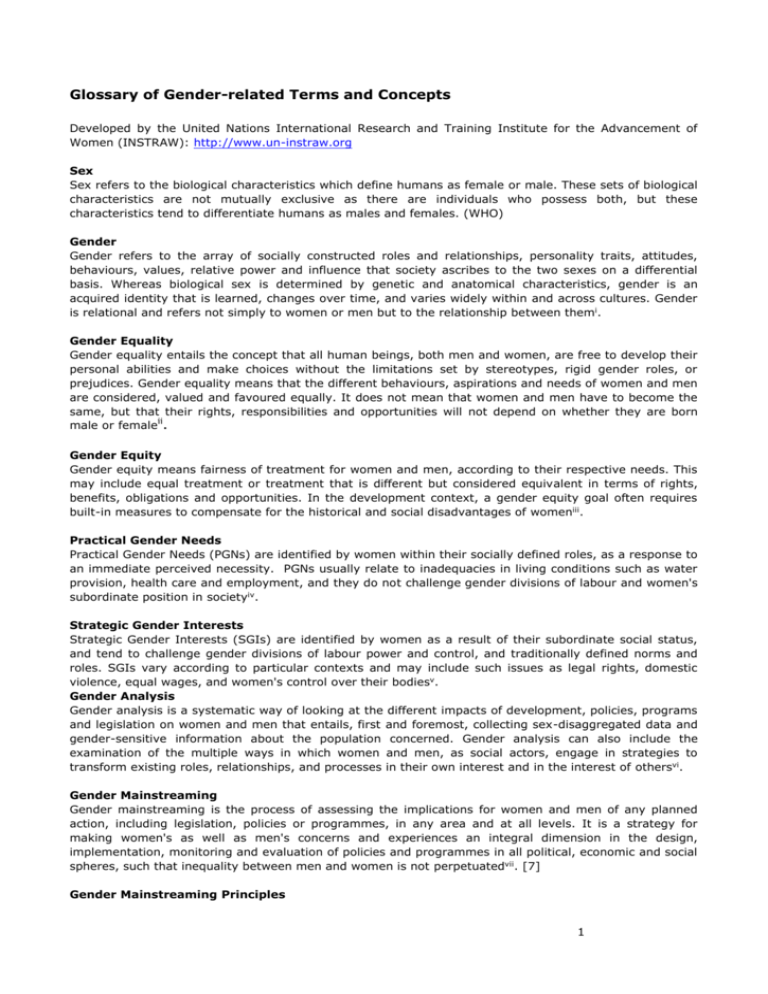
Glossary of Gender-related Terms and Concepts Developed by the United Nations International Research and Training Institute for the Advancement of Women (INSTRAW): http://www.un-instraw.org Sex Sex refers to the biological characteristics which define humans as female or male. These sets of biological characteristics are not mutually exclusive as there are individuals who possess both, but these characteristics tend to differentiate humans as males and females. (WHO) Gender Gender refers to the array of socially constructed roles and relationships, personality traits, attitudes, behaviours, values, relative power and influence that society ascribes to the two sexes on a differential basis. Whereas biological sex is determined by genetic and anatomical characteristics, gender is an acquired identity that is learned, changes over time, and varies widely within and across cultures. Gender is relational and refers not simply to women or men but to the relationship between themi. Gender Equality Gender equality entails the concept that all human beings, both men and women, are free to develop their personal abilities and make choices without the limitations set by stereotypes, rigid gender roles, or prejudices. Gender equality means that the different behaviours, aspirations and needs of women and men are considered, valued and favoured equally. It does not mean that women and men have to become the same, but that their rights, responsibilities and opportunities will not depend on whether they are born ii male or female . Gender Equity Gender equity means fairness of treatment for women and men, according to their respective needs. This may include equal treatment or treatment that is different but considered equivalent in terms of rights, benefits, obligations and opportunities. In the development context, a gender equity goal often requires built-in measures to compensate for the historical and social disadvantages of womeniii. Practical Gender Needs Practical Gender Needs (PGNs) are identified by women within their socially defined roles, as a response to an immediate perceived necessity. PGNs usually relate to inadequacies in living conditions such as water provision, health care and employment, and they do not challenge gender divisions of labour and women's subordinate position in societyiv. Strategic Gender Interests Strategic Gender Interests (SGIs) are identified by women as a result of their subordinate social status, and tend to challenge gender divisions of labour power and control, and traditionally defined norms and roles. SGIs vary according to particular contexts and may include such issues as legal rights, domestic violence, equal wages, and women's control over their bodiesv. Gender Analysis Gender analysis is a systematic way of looking at the different impacts of development, policies, programs and legislation on women and men that entails, first and foremost, collecting sex-disaggregated data and gender-sensitive information about the population concerned. Gender analysis can also include the examination of the multiple ways in which women and men, as social actors, engage in strategies to transform existing roles, relationships, and processes in their own interest and in the interest of othersvi. Gender Mainstreaming Gender mainstreaming is the process of assessing the implications for women and men of any planned action, including legislation, policies or programmes, in any area and at all levels. It is a strategy for making women's as well as men's concerns and experiences an integral dimension in the design, implementation, monitoring and evaluation of policies and programmes in all political, economic and social spheres, such that inequality between men and women is not perpetuatedvii. [7] Gender Mainstreaming Principles 1 Gender mainstreaming means: – forging and strengthening the political will to achieve gender equality and equity, at the local, national, regional and global levels; – incorporating a gender perspective into the planning processes of all ministries and departments of government, particularly those concerned with macroeconomic and development planning, personnel policies and management, and legal affairs; – integrating a gender perspective into all phases of sectoral planning cycles, including the analysis development, appraisal, implementation, monitoring and evaluation policies, programmes and projects; – using sex-disaggregated data in statistical analysis to reveal how policies impact differently on women and men; – increasing the numbers of women in decision-making positions in government and the private and public sectors; – providing tools and training in gender awareness, gender analysis and gender planning to decisionmakers, senior managers and other key personnel; – forging linkages between governments, the private sector, civil society and other stakeholders to ensure a better use of resourcesviii. Gender-Neutral, Gender-Sensitive, and Gender Transformative The primary objective behind gender mainstreaming is to design and implement development projects, programmes and policies that: 1 do not reinforce existing gender inequalities (Gender Neutral) 2 attempt to redress existing gender inequalities (Gender Sensitive) 3 attempt to re-define women and men’s gender roles and relations (Gender Positive / Transformative) The degree of integration of a gender perspective in any given project can be seen as a continuum ix: Gender Negative Gender inequalities are reinforced to achieve desired development outcomes Gender Neutral Gender Sensitive Gender is not Gender is a means considered relevant to reach set to development development goals outcome Addressing gender Gender norms, norms, roles and Uses gender norms, roles and relations access to resources roles and are not affected in so far as needed stereotypes that (worsened or to reach project reinforce gender improved) goals inequalities Gender Positive Gender Transformative Gender is central to achieving positive development outcomes Gender is central to promoting gender equality and achieving positive development outcomes Changing gender norms, roles and access to resources a key component of project outcomes Transforming unequal gender relations to promote shared power, control of resources, decision-making, and support for women’s empowerment Women in Development Women in Development (WID) projects were an outcome of the realization that women's contributions were being ignored and that this was leading to the failure of many development efforts. WID projects were developed to involve women as participants and beneficiaries of development aid and initiatives x. Gender and Development The Gender and Development (GAD) approach was developed as a response to the failure of WID projects to effect qualitative and long-lasting changes in women’s social status. GAD focuses on social, economic, political and cultural forces that determine how men and women participate in, benefit from, and control project resources and activities differently. This approach shifts the focus from women as a group to the socially determined relations between women and men. Participatory Development Participatory development implies a partnership which is built on a dialogue among the various actors (stakeholders), during which the 'agenda' is set jointly and a variety of local views and indigenous 2 knowledge are deliberately sought and respected. Participatory development implies negotiation rather than the dominance of an externally set project agendaxi. Resources Resources are means and goods, including those that are economic (household income) or productive (land, equipment, tools, work, credit); political (capability for leadership, information and organization); and time. Access Access to resources implies that women are able to use and benefit from specific resources (material, financial, human, social, political, etc). Control Control over resources implies that women can obtain access to a resource as and can also make decisions about the use of that resource. For example, control over land means that women can access land (use it), can own land (can be the legal title-holders), and can make decisions about whether to sell or rent the land. Benefits Economic, social, political and psychological retributions derived from the utilization of resources, including the satisfaction of both practical needs (food, housing) and strategic interests (education and training, political power)xii Empowerment Empowerment implies people - both women and men - taking control over their lives: setting their own agendas, gaining skills (or having their own skills and knowledge recognized), increasing self-confidence, solving problems, and developing self-reliance. It is both a process and an outcomexiii. Empowerment implied an expansion in women's ability to make strategic life choices in a context where this ability was previously denied to themxiv. Reproductive Rights Reproductive rights rest on the recognition of the basic right of all couples and individuals to decide freely and responsibly the number, spacing and timing of their children and to have the information and means to do so, and the right to attain the highest standard of sexual and reproductive health. They also include the right of all to make decisions concerning reproduction free of discrimination, coercion and violencexv. Sexual rights Sexual rights embrace human rights that are already recognized in national laws, international human rights documents and other consensus documents. These include the right of all persons, free of coercion, discrimination and violence, to: the highest attainable standard of health in relation to sexuality, including access to sexual and reproductive health care services; seek, receive and impart information in relation to sexuality; sexuality education; respect for bodily integrity; choice of partner; decide to be sexually active or not; consensual sexual relations; consensual marriage; decide whether or not, and when to have children; and pursue a satisfying, safe and pleasurable sexual lifexvi. i Exploring Concepts of Gender and Health. Ottawa: Health Canada, 2003 http://www.hc-sc.gc.ca/english/women/exploringconcepts.htm ABC of Women Worker's Rights and Gender Equality, Geneva: ILO, 2000. iii Ibid. and Gender and Household Food Security. Rome: International Fund for Agricultural Development, 2001. http://www.ifad.org/gender/glossary.htm iv Vainio-Mattila, A. Navigating Gender: A framework and a tool for participatory development. Helsinki: Finland Ministry for Foreign Affairs, 1999. http://global.finland.fi/julkaisut/taustat/nav_gender/glossary.htm v Ibid vi ] Health Canada, 2003 and ILO 2000 and Gender and Biodiversity Research Guidelines. Ottawa: International Development Research Centre, 1998. http://www.idrc.ca:8080/biodiversity/tools/gender1_e.cfm ILO ii vii Agreed Conclusions on Gender Mainstreaming. Geneva: United Nations Economic and Social Council, 1997. http://www.un.org/documents/ecosoc/docs/1997/e1997-66.htm 3 viii ] Gender Equality and Equity: A summary review of UNESCO's accomplishments since the Fourth World Conference on Women (Beijing 1995). Geneva: United Nations Educational, Scientific and Cultural Organizations, 2000. ix Adapted from Eckman, A, 2002 x Vainio-Mattila 1999 xi Vainio-Mattila 1999 xii Unveiling Gender: Basic Conceptual Elements for Understanding Equity. San Jose: World Conservation Union, 1999. http://www.generoyambiente.org/ES/publicaciones_uicn/equidadi/Mod9i/mod9i.htm xiii IDRC 1998 xiv ] Kabeer, N. “Reflections on the Measurement of Women’s Empowerment.” In Discussing Women’s Empowerment: Theory and Practice. Stockholm: Sida Studies No. 3, 2001. xv Programme of Action of the International Conference on Population and Development. Geneva: United Nations, 1994, para 7.3 http://www.unfpa.org/icpd/icpd_poa.htm#ch7 xvi Gender and Reproductive Rights Glossary. Geneva: World Health Organization, 2002 http://www.who.int/reproductivehealth/gender/glossary.html 4

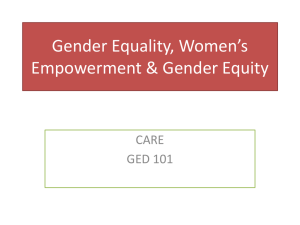
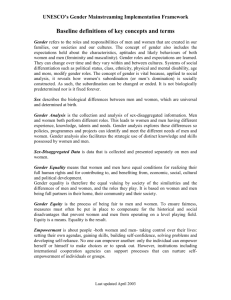


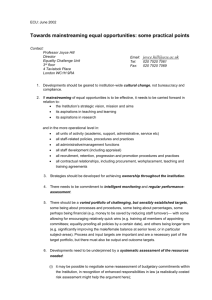
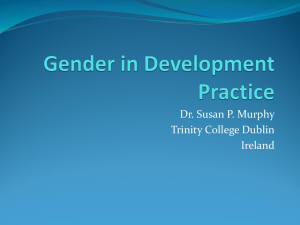

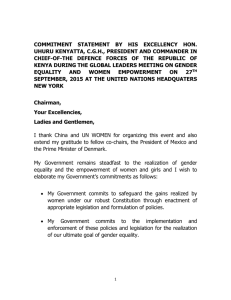
![Gender mainstreaming in higher education [PPTX 1.25MB]](http://s3.studylib.net/store/data/009261055_1-dfa19b70fcd91637c7a1dbd1bc939bd3-300x300.png)
